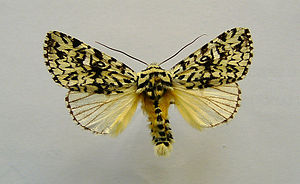Yellow ermine
| Yellow ermine | ||||||||||||
|---|---|---|---|---|---|---|---|---|---|---|---|---|

Yellow ermine ( Trichosea ludifica ) |
||||||||||||
| Systematics | ||||||||||||
|
||||||||||||
| Scientific name | ||||||||||||
| Trichosea ludifica | ||||||||||||
| ( Linnaeus , 1758) |
The yellow ermine ( Trichosea ludifica ), sometimes also called mountain ash owl, is a very rare and endangered butterfly ( moth ) from the subfamily of the Pantheinae within the owl butterflies (Noctuidae).
features
butterfly
The yellow ermine is a medium-sized butterfly with a wingspan of 38 to 43 millimeters. The head and thorax are greenish-white with two black dots on the top. When viewed from above, the thorax is outlined with a black line. The abdomen of the moth is yellowish and has black spots on the back on each segment. The basic color of the forewings is whitish to greenish, with irregularly distributed black spots and clearly drawn, jagged, sometimes interrupted transverse lines and central shadows. Ring and kidney defects are outlined in black. The hind wings of the male are yellowish-white with black veins. At the inner edge the color becomes more intense yellow. The hind wings of the females are blackish gray with black veins. The fringes of all wings are alternately black and white piebald.
Caterpillar
The caterpillar has a gray-blue basic color with orange-red back and side back lines. On the sides there are black, yellow-bordered spots with a yellow center line on each side segment. The side stripes are white, the stigmas outlined in black and yellow. There is a whitish blemish on the back behind the third and the last segment. The hair is thin and brown-yellow in color. The hair stands on small black warts. The hair of the 11th segment, standing on a divided cone, is black and long. The head of the caterpillar is somewhat flattened in front and blackish in color.
Doll
The doll is stocky and shiny brown. The Kremaster is short.
Similar species
There is a certain similarity to the nun ( Panthea coenobita ). The main distinguishing feature, however, is the yellowish body of the yellow ermine.
Geographical distribution and habitat
The yellow ermine has a very extensive distribution area, ranging from the Iberian Peninsula in the west to the Far East (Amur region, northern China, Japan and Korea). In the south it ends in northern Spain, northern Italy and the northern Balkan Peninsula. In the north, the yellow ermine occurs to central Finland and northern Russia. The species is almost completely absent from the British Isles and the Scandinavian Peninsula (with the exception of a small occurrence in Skåne). However, the occurrence is very isolated and many earlier occurrences are probably already extinct (e.g. in Baden-Württemberg ). In Spain only a few observations are known in the area around Madrid and in the northern center. In Germany there is only evidence from the Bavarian Alpine foothills. In Central Europe the species is only found sporadically in western France, Switzerland, Austria, the Czech Republic, Slovenia, Romania and southern Poland. The species has been detected in the Alps at heights of up to 1,300 meters. It occurs preferentially in hilly or mountainous terrain.
Way of life
The yellow ermine is bivoltine; d. H. two generations are trained each year. The moths of the first generation fly in May and June, the moths of the second generation in August and September. They are nocturnal and also fly to artificial light sources .
The caterpillars feed on the leaves of various deciduous trees and bushes, such as B. Rowan ( Sorbus aucuparia ), oak ( Quercus ), birch ( Betula ), prunus , pear ( Pyrus ), apples ( Malus ), roses ( Rosa ), linden ( Tilia ), elm ( Ulmus ), hornbeam ( Carpinus ), Buckthorn ( Rhamnus ) and willow ( Salix ).
The pupa overwinters in a dense white web.
protection
The species is particularly protected in Germany in all areas of its occurrence.
swell
Individual evidence
- ↑ The Light of Need (PDF; 1.8 MB)
- ↑ a b Fibiger et al. (2009: p. 22/3)
- ^ Forster & Wohlfahrt (1971: p. 238/9)
- ↑ Fernández J.; Cifuentes J.; Romera L.; Alcobendas M.; Viejo JL: Los Noctuidae de Madrid (España) I: Subfamilias Pantheinae, Eariinae, Cloephorinae, Sarrothripinae, Nolinae, Herminiinae, Hypeninae, Gonopterinae, Calpinae, Catocalinae, Eustrotiinae. SHILAP Revista de Lepidopterología, 33 (132): 467-485, 2005 ISSN 0300-5267 PDF ( page no longer available , search in web archives ) Info: The link was automatically marked as defective. Please check the link according to the instructions and then remove this notice.
- ^ Josef Wolfsberger: New and interesting macro epidopteran finds from Bavaria and the adjacent northern limestone Alps . Bulletin of Bavarian Entomologists 23 (3): 33-56, 1974
- ↑ Federal Species Protection Ordinance Annex 1
literature
- Michael Fibiger, László Ronkay, Axel Steiner & Alberto Zilli: Noctuidae Europaeae Volume 11 Pantheinae, Dilobinae, Acronictinae, Eustrotiinae, Nolinae, Bagisarinae, Acontiinae, Metoponiinae, Heliothinae and Bryophilinae. 504 pp., Entomological Press, Sorø 2009 ISBN 978-87-89430-14-0
- Manfred Koch : We determine butterflies. Volume 3: Owls. 2nd, expanded edition. Neumann, Leipzig / Radebeul 1972, DNB 760072930 .
- Walter Forster , Theodor A. Wohlfahrt : The butterflies of Central Europe. Volume 4: Owls. (Noctuidae). Franckh'sche Verlagshandlung, Stuttgart 1971, ISBN 3-440-03752-5 .
Web links
- Lepiforum e. V. Photos
- Occurrence and endangerment in Germany
- Trichosea ludifica at Fauna Europaea